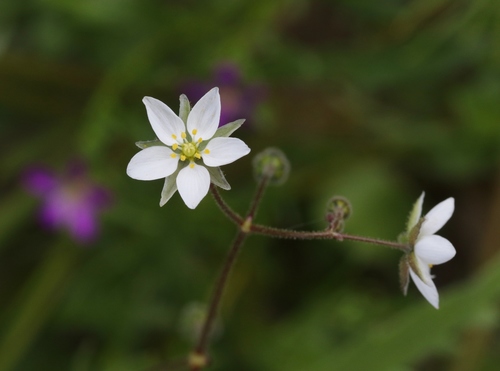Corn spurrey
Search
Wikipedia
This article needs additional citations for verification. (November 2015)
|
| Spergula arvensis | |
|---|---|

| |
|
Scientific classification | |
| Kingdom: | Plantae |
| Clade: | Tracheophytes |
| Clade: | Angiosperms |
| Clade: | Eudicots |
| Order: | Caryophyllales |
| Family: | Caryophyllaceae |
| Genus: | Spergula |
| Species: |
S. arvensis
|
| Binomial name | |
|
Spergula arvensis | |
Spergula arvensis, the corn spurry, stickwort, starwort or spurrey, [1][2] is a species of plant in the genus Spergula.[3]
Description
Corn spurry is a summer or winter annual broadleaf plant, and its seeds buried in the soil can survive for several years. The leaves contain a compound called oxalate that can be toxic if eaten in large quantities by livestock.[4]
Flower
Perfect flower with 5 white tiny petals and 5 green sepals slightly offset from petals. There are also 10 yellow stamens about 1 cm in diameter.[5]
Taxonomy and nomenclature
Spergula arvensis var. arvensis and S. arvensis var. sativum are the distinct variants, that have been found in the UK and the chromosome number: 2n = 18. [3][6]
It is the county flower of Montgomeryshire in the United Kingdom.
It is considered a cosmopolitan agricultural weed.[3][6]
Habitats
Roadsides, farmland, sand dunes, and coniferous woodland. [4] A kind of plant, which can be found in almost all over the world, including Britain. [7]
Reproduction
Corn spurry can be reproduced by the following ways:
- Free spread of the weed – Because of the high seed yield rate of corn spurry, it can produce 10-40 fruits (capsules) per plant, and each capsule produces about 20 seeds in summer and autumn. It also produces seeds while flowering, that is, the upper part of the same plant is still blooming, and the lower part of the mature seeds have dropped. Corn spurry has small, lightweight seeds that can be spread by the wind and cover adjacent land the next year.
- Ruminants spread – The excrement of ruminants can also be transmitted. After eating ruminants, their mature seeds cannot be digested in the stomach of the animal, and they can continue to germinate and grow after they are expelled from the excrement. Therefore, although some suitable habitats are far away, they can be transmitted and reproduced through the livestock trade.[8]
Prevention
It takes less time and money to prevent crops from corn spurry than it does to control corn interference. When planting in a new area, you should plant registered seeds. Ensure that infected areas are well cleaned to ensure that seeds are not transferred. [9]
Corn spurry control
Cultural control
Corn spurries do not germinate in very deep soil, thus, conventional planting methods can bury some of them. Experimental studies have shown that the germination rate decreases as the depth of seeds buried in the soil increases. [10] However, being buried increases the life span of the seeds, which means that they end up on the surface of the soil as a result of cultivation. Therefore, once the ideal soil and weather conditions are achieved, plant high-yield crops in the field as soon as possible, with narrower rows and higher number of plants between the crops. [9]
Physical control
Before sowing the seeds of the crops, some mechanical methods can be carried out, such as hand hoeing, ploughing, grazing and so on.[11]
Chemical control
Chemicals can be applied to control corn spurry, but this variety is resistant to many kinds of herbicides.[11]
Biological control
It is known that few insects and pathogens can attack corn spurry, while an arbuscular-mycorrhizal fungal inoculum has been shown to be effective in reducing the biomass of weeds.[12]
References
- ^ "Pest Information". pestweb.com.
- ^ "Spergula arvensis". Natural Resources Conservation Service PLANTS Database. USDA. Retrieved 25 November 2015.
- ^ a b c New, June K. (1961). "Spergula Arvensis L.". Journal of Ecology. 49 (1): 205–215. doi:10.2307/2257434. JSTOR 2257434.
- ^ a b "Corn spurry (Spergula arvensis)". ipm.ucanr.edu.
- ^ "Corn spurry (Spergula arvensis)". oregonstate.edu.
- ^ a b "Spergula arvensis (corn spurry)". www.cabi.org.
- ^ "Spergula arvensis - L." pfaf.org.
- ^ "Spergula arvensis L." indiabiodiversity.org.
- ^ a b "Corn Spurry (Spergula arvensis L.)". pfaf.org.
- ^ Benvenuti, S.; Macchia, M.; Miele, S. (2001). "Quantitative analysis of emergence of seedlings from buried weed seeds with increasing soil depth". Weed Science. 49 (4): 528–535. doi:10.1614/0043-1745(2001)049[0528:qaoeos]2.0.co;2.
- ^ a b "Corn Spurry (Spergula arvensis L.)" (PDF). pfaf.org.
- ^ "Corn Spurry". gardenorganic.org.uk.
| Wikimedia Commons has media related to Spergula arvensis. |
